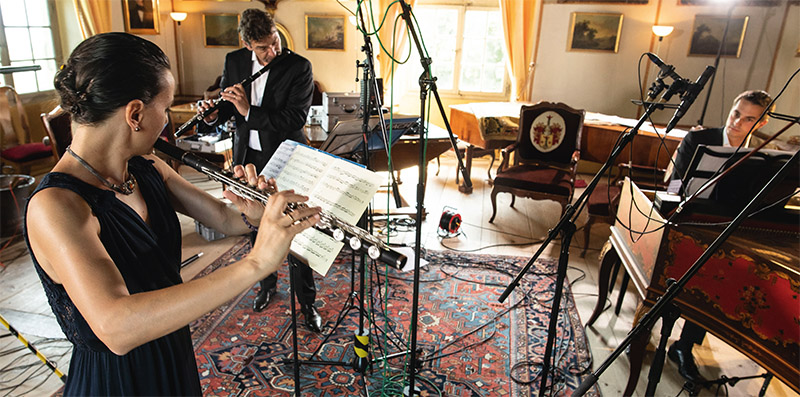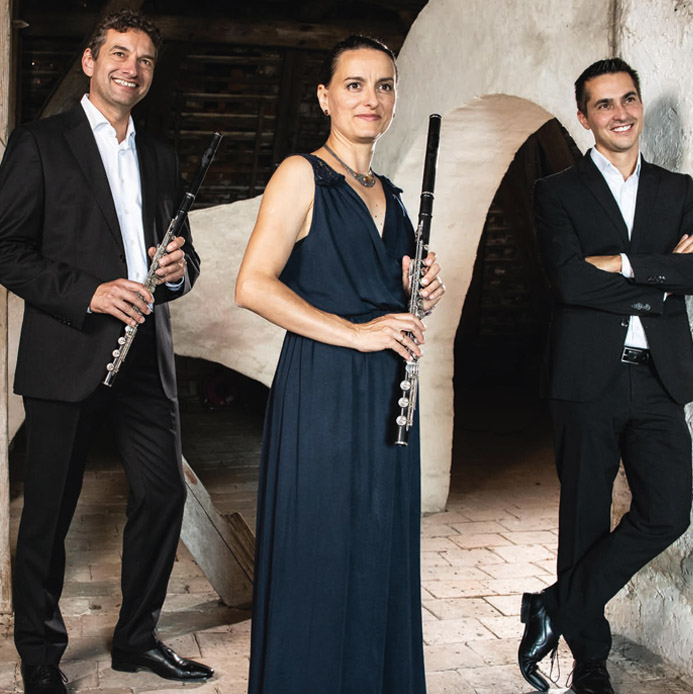Bach | Trio Sonatas
KASPAR ZEHNDER, ANA OLTEAN & VITAL JULIAN FREY


Copyright: Trio Sonatas PR
KASPAR ZEHNDER | ANA OLTEAN | VITAL JULIAN FREY
JOHANN SEBASTIAN BACH (1685-1750) TRIOSONATA G MAJOR BWV 1039 * TRIOSONATA C MAJOR BWV 1037 * INTERMEZZO I * TRIOSONATA D MINOR BWV 1036 * INTERMEZZO * TRIOSONATA D MAJOR BWV 1028 * TRIOSONATA G MINOR BWV 1029
Johann Sebastian Bach’s musical genius is undisputed, but it does not solely originate from within itself. Bach also conducted research into and seized ideas from his paragons and from neighboring national styles which he studied. The viol and trio sonatas BWV 1028-1039 mirror these processes. They point toward the future and enlighten us about Johann Sebastian Bach’s motivation to pass on his legacy to younger generations. The sonata as a genre, however, was still a long ways away from classical convention, which much later usually required a solo instrument plus “accompaniment.” The baroque sonata is first and foremast a form for three – in the case of this CD, for flutists Ana Ionna Oltean and Kasper Zehnder, as well as Vital Julian Frey, who constitutes the binding element with his basso-continuo-part on the cembalo.
Another music-historical particularity is important to note here: The sonatas BWV 1036 and 1037 are testament to the close collaboration between Johann Sebastian Bach and his students. It is indeed possible that these two works present impressively premature and confident attempts at composition by Carl Philipp Emanuel Bach and Johann Gottlieb Goldberg.
All typical “Bach qualities” are revealed throughout this group of works: following the lofty elegance of sonata BWV 1039, BWV 1037 shows an almost sacral festivity. Next is an accurately functionalized intermezzo: regarding dramaturgic interludes, the fragile group of chords in Sinfonia BWV 799 is true to the baroque definition of the generic term.
Despite all strict formality, Bach’s musical composition remains deeply emotional, as is apparent in the stirring gestus of Sonata BWV 1036. As an additional interplay follows the light-footed, heartfelt Prelude BWV 869, which is normally part of the well-tempered piano. In this case, it serves as a connection to two works that were originally meant to be viol sonatas, BWV 1028 and BWV 1029. The latter shines with brilliant contrapuntal finesse.
Executed with strong formal discipline, each of these master works, compressed to around fifteen minutes in length, show a strong continuity in affect. All contradiction between Bach’s authority and playful lightness appears dissolved. In this recording, this is stressed forcefully by the chosen constellation of two flutes plus cembalo.
Furthermore, three distinctive characters with various geographical and artistic backgrounds are united here: the Romanian flutist Ana Iona Oltean and her Swiss partner Kaspar Zehnder are also partners in life – an excellent precondition for a deeply rooted musical consensus. The couple and their children live in Bern, and they begun playing concerts together in 1999. Charles Koechlin’s four-hour long cycle „Les chants de nectaire” was met with a lot of interest during a scenic night concert. More recently, their shared CD project with chamber music by Günter Raphael has received critical attention.
Ana Iona Oltean was born in Romania. After her basic studies at a musical lyceum and the musical academia at Cluj-Napoca, she became a student of Heidi Indermühle’s at the HK Bern. She received her soloist diploma and was awarded the Eduard-Tschumi-Price in 2002.
She specializes in the transverse flute and is a passionate musical pedagogist. Her book “The Role of the Body in Playing an Instrument” is internationally renown and is the basis for her teaching at various music academies and colleges throughout Europe.
Kaspar Zehnder is not only a passionate chamber musician but has also worked as chief conductor of the theater orchestra Biel Solothurn TOBS since 2012. Since 2018, he has also been conducting the Hradec Philharmonic Orchestra in Králové/Czeck Republic. From 1999-2020, he served as artistic director of Murten Classics. Since 2015, he curates the Festival Klanganstrich in his birthplace Riggisberg.
The third musician in this group is a true specialist: Cembalist Vital Julian Frey began studying cembalo at age eight, without a (usually common) detour through the piano. He was a student of Robert Hill’s in Freiburg in Breisgau, of Christophe Rousset’s in Paris, and of Christien Schornsheim’s in Munich (soloist diploma). Especially defining were his private studies with Gustav Leonhardt in Amsterdam. As a soloist and chamber musician, Vital Julian Frey can frequently be heard playing at renowned festivals domestically and internationally. Since 2016, he also been working in the role of artistic director at the Bach weeks in Thun.